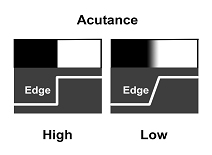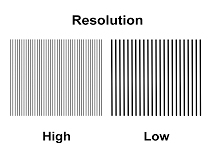Trilinear-array vs bayer-array digitisation – a comparison of technologies
Acutance (or what we colloquially call contrast) describes how quickly image information changes from dark to light on an edge, and high acutance results in sharp transitions and detail with clearly defined borders, which we perceive as higher contrast, and correspondingly, greater sharpness.
Resolution describes the camera’s ability to distinguish between closely spaced elements of detail, such as the two sets of lines shown above. Sharpness increases as a factor of resolution, and this is one of the reasons that NARA and FADGI’s digitisation guidelines both recommend no sharpening of high resolution images.
Photographs require both high acutance and resolution to be perceived as critically sharp. A trilinear array based scanner gives an operator much greater overall control over both elements than a bayer array-based camera.
This is not to say that a digital camera solution should not be considered. NZMS use digital camera technologies in an increasing range of work for clients – and the financial benefits to clients are obvious – and we believe that an informed decision should always be made about whether the capture equipment is the best fit for purpose. There may be items in your collections which may suit digital camera digitisation over high end scanner digitisation and the final choice should be yours.
For more in-depth explanation of Trilinear-array vs bayer-array digitisation, download our PDF]]>


